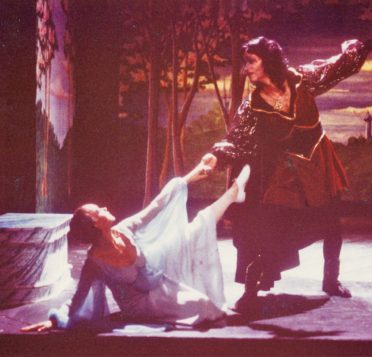By Neal Newman,
February 28, 2020

Why is the Irish Theatre so extraordinary? Certainly, this rich, green land has had its history of troubles: Remember the invasion of Henry VIII’s armies in 1529? Or the great famine of 1840 which began the diaspora that continues to this day? Or the Easter Uprising? Or the great troubles of the 1970s? All of this misery has occurred, but through some majestic magic, the Irish poets have somehow turned this gruesome history into beautiful art. The Easter rising, unspeakable as it was, has produced so many fine plays, and glorious songs that the soul thrills to the resplendent beauty of these works.
Novelist-poet-playwright Sebastian Barry has exorcised the memory of his great grandfather in THE STEWARD OF CHRISTENDOM. This notorious policeman here called Thomas Dunne, was the master of Dublin Castle, the center of British rule, in the brutal years of 1913-1922. Believe it or not, he was a Catholic, and loyal Irishman who viewed the Brits through a Rudyard Kipling kaleidoscope. But this is not like the well-known film SHAKE HANDS WITH THE DEVIL as the author chooses another concept. He has set his play in a Wicklow County asylum ten years after the creation of the Irish Free State. Here a 70-year-old madman drifts in and out on lucidity in the year 1932. His addled mind meanders back to 1923, the year of his downfall. His three daughters continually drift into his visions, while one of them, a bitter spinster, actually visits him in reality. Theatergoers will notice the influences of James Joyce, O’Neill’s TOUCH OF THE POET, and KING LEAR. In this case, the scene on the heath runs the entire two and one-half hours playing time.
Irish playwrights create for a public that knows Dublin’s history well. There is, therefore, no attempt to illuminate these days-of-old stories for American audiences which can be frustrating. Fortunately, dramaturg Amy Hodgdon has written an outstanding program glossary detailing the entire epic. If the words “DMP”, “black and tan” or “Michael Collins” are meaningless to you, be sure to arrive early to ponder it all.
The production at the Irish Heritage Theatre, (co-produced with Plays and Players), has much to admire. Local artist Hugo DeLao has designed a simple but striking set that weaves easily between the timespans, while Andrew Cowles wonderfully atmospheric lighting keeps the audience aware of which time period we are in. The uncredited costumes were apt, (except for Dolly’s modern dress and shoes), and dialect coaches Kirsten Quinn and Michael Toner assisted the strong cast in capturing the music and sounds of Irish speech. This performance does not sound like Americans trying to “do” Irish.

It must be admitted that Sebastian Barry is an incredibly dense poet. When I first studied the script, I noted the beauty and brilliance of the imagery and the rhythm and tempo of the words, especially in the multitudinous lengthy speeches for Dunne which comprise more half of the play. What works on the page seems overwritten or incomprehensible on the stage, which might mean that Barry is a better poet than playwright, or that leading actor Monroe Barrick has yet to orchestrate the verbosity for maximum theatrical effect. The answer is probably both.

Director James Schlatter has staged the play well, always clarifying where or when we are. He has wisely concentrated on character and has elicited deeply felt, complex performances. This is a good thing because Barry is not the most dramatic of writers. For example, for the grand event of Act Two, Dunne takes his uniform’s sword and threatens his daughter. This eventually sends him to the asylum. For a play about the “Devil of Dublin Castle” that’s not much of a dramatic moment. The evening also needs more shaping and rhythmic pacing to create a theatrical event that will lead to an evening’s end climax. This playwright needs all the help from the director he can get. The action, as directed, is also too small even for the intimate Plays and Players theater. Many of the moments seem more appropriate for film or television, rather than the stage, with many events going unseen or unheard.
Since Thomas Dunne is frequently musing in his own mind, the best scenes involve the three daughters. Brittany Holdahl, (Maud), cleverly handles one of the play’s few comic moments when she strives to admit a suitor into Dublin Castle. Donovan Lockett, (Dolly), exudes warmth, (another rare quality here), as the favorite daughter who will soon depart to make a home in America. Stephanie Iozzia gives the richest performance as the bitter Annie. She is the one person who has the maturity and good sense to understand the importance of the revolt and the consequences of the family being forced to move to a farm in the new Irish State. She is a marvelous listener and her deeply felt reaction to her father’s dismissal of Michael Collins is a highlight. But where was the polio swayback? John O’Donnell and Peggy Smith are fine in smaller roles. Lincoln Millard, a recent college graduate, is sensitive and effective as the ghost of the lost son, still in his World War One uniform. Much of the power of the role, however, is lost by not casting a twelve-year-old in the part as the script demands. Older people frequently tend to only remember sons and daughters as children, and dressing a young boy in a war uniform is one of Barry’s few intriguing theatrical strokes.

THE STEWARD OF CHRISTENDOM is very nearly a one-man play. Dunne never leaves the stage and Monroe Barrick is a compelling presence in his ever-present filthy longjohns. He is a convincing policeman who believes that he is truly a steward of the magnificent British empire. He cares for his family in his own obtuse way, and there are many inspired exchanges. Many of these moments, sadly, do not make it past the third row, and much of his dialogue is difficult to understand.
This is play for SERIOUS theatergoers, and Artistic Director Peggy Mecham is to be applauded for bringing it to Philadelphia. The characters and emotions commend the evening even if the poetry demands the purchasing of a script.
RUNNING TIME: Two hours thirty minutes, including intermission.
THE STEWARD OF CHRISTENDOM plays through Sunday, March 15 at the Plays and Players Theater, 1714 Delancy Place in Philadelphia. Tickets can be purchased at the box office, 215-735-0630. or at irishheritagetheatre.org.
